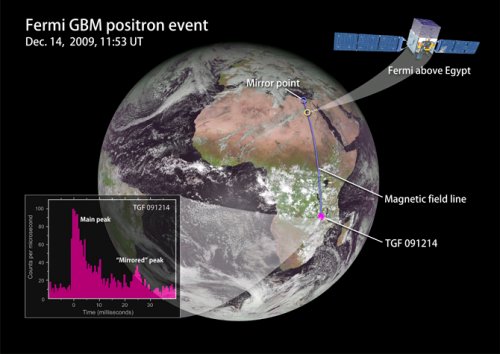
By Hamish Johnston at the AAS meeting in Seattle
Everyone likes a good thunderstorm – the spectacular flashes, crashes and wind, and then calm, clear air. But for the past few years physicists have begun to realize that thunderstorms can generate very-high-energy gamma rays – 100 MeV being the highest seen so far.
Now, researchers have discovered that these gamma rays are creating beams of positrons (the antimatter version of electrons) and hurling them into space!
These bizarre discoveries have come about thanks to the Fermi gamma ray telescope – the primary mission of which is to scan the heavens for gamma ray bursts. However, the satellite can’t help detecting terrestrial gamma ray bursts (TGBs) and once it determined that they are a regular occurrence over the tropics it was optimized to look down as well as up.
While most TGBs last about a millisecond, Fermi has seen events that last for much longer. What’s more intriguing is that one of these events appeared to occur over southern Egypt, where there was no thunderstorm activity.
Loving a good mystery, Michael Briggs at the University of Alabama and colleagues decided to investigate. One thing that they noticed was a preponderance of gamma rays at 511 keV, which are produced when electrons and positrons annihilate.
The positrons are created when high-energy gamma rays scatter off atoms in the atmosphere, converting into electron–positron pairs. Even more electrons are created by other scattering processes and, being charged particles, the electrons and positrons travel along Earth’s magnetic field lines. As they travel, they collide with gas atoms and can emit gamma rays.
So what does this have to do with the TGB over Egypt? What Briggs and colleagues think is that the initial TGB occurred thousands of miles away in southern Africa, sending a beam of electrons and positrons hurling up and over Egypt, where collisions produced gamma rays. See the above figure.
The charged particles kept going to a mirror point, where they were reflected back down over Egypt – creating a second pulse. This entire process took less than 30 ms.
Amazingly, physicists have only known about these high-energy bursts for a decade or so. The problem, according to Briggs, is that they are difficult to detect here on Earth because the gamma rays are absorbed by the dense lower atmosphere. However, they have been seen at certain high-altitude facilities and at sea level in Japan, where thunderstorms are believed to occur lower in the sky than in most places.
The big mystery, however, remains how such high-energy gamma rays are created in the first place.



